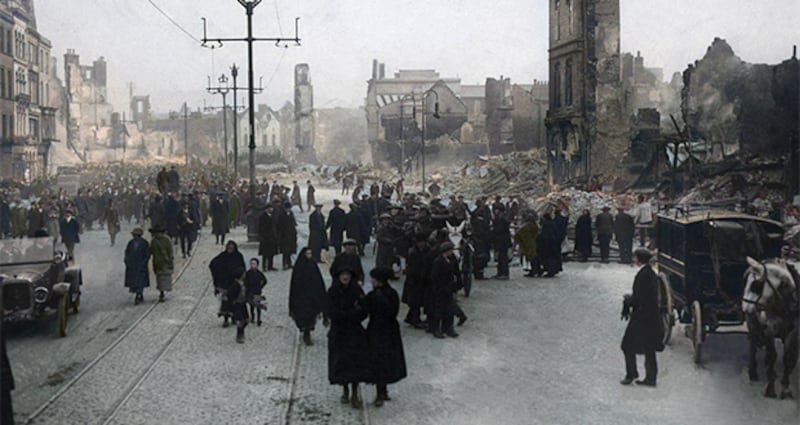January 2nd: The War of Independence begins in earnest with an attack on Carrigtwohill RIC barracks in Co Cork.
January 15th: Sinn Féin has major successes in the first local elections since the historic British general election of December 1918.
February 18th: Timothy Quinlisk, an ex-British soldier who joined Casement's Brigade in the first World War, is shot dead in Cork by the IRA. He is the first civilian to be killed for suspected spying in Cork.

February 27th: The Home Rule Bill is published, allowing for a 52-seat assembly in Northern Ireland and a 128-member parliament in Southern Ireland.
March 20th: Sinn Féin's lord mayor of Cork, Tomás Mac Curtain, is shot dead in his home on Thomas Davis Street, Blackpool, by a gang suspected to be rogue Royal Irish Constabulary officers led by District Inspector Oswald Swanzy.
March 25th: The first Black and Tans arrive in Ireland. They are named after the Scarteen Black and Tan hunt in Co Tipperary.
April 2nd: Sir Hamar Greenwood, a Canadian-born Liberal lawyer, replaces Ian MacPherson as chief secretary of Ireland.
April 5th: IRA prisoners begin a hunger strike in Mountjoy Jail looking for political status, which is granted.
May 10th: The British release 40 IRA prisoners from Wormwood Scrubs.
May 20th: Dublin dock workers refuse to handle British war material and are joined by railway workers, who refuse to transport British troops around the country.
June 27th-July 2nd: Soldiers in the 1st battalion of the Connaught Rangers based in India mutiny over conditions in Ireland. Sixty-one are arrested and 14 sentenced to death, though just one is executed.
July 21st: Sectarian tensions in the North lead to the expulsion of Catholic dockworkers from the Harland and Wolff shipyards in Belfast, prompting two years of violence which leaves 440 people dead, most of them Catholics.
July 23rd: Fourteen die in Belfast riots.
July 27th: The first members of the Auxillary Division of the Royal Irish Constabulary (ADRIC) arrive in Ireland.
August 19th: Tómas MacCurtain's successor as lord mayor of Cork, Terence MacSwiney, is court-martialed for sedition. He refuses to recognise the jurisdiction of the courts and goes on hunger strike in Brixton Prison.
August 22nd: Oswald Swanzy, the man widely blamed for the assassination of Tómas MacCurtain, is gunned down in Lisburn. The killing provokes the expulsion of much of the Catholic population of the town and more sectarian rioting.
September 20th: In response to the shooting dead of two RIC men in a pub, the Black and Tans and RIC go on the rampage in Balbriggan, Co Dublin, burning houses and bayoneting to death two suspected Republicans. The town is visited by members of the American Committee for Relief in Ireland and the images are circulated around the world.
September 20th: Three British soldiers from the Duke of Wellington's Regiment are shot dead while delivering a consignment of bread from a bakery. The youngest is Pte Harold Washington, who was just 15 years old. One of the ambush party is arrested at the scene. He is Kevin Barry, an 18-year-old UCD medical student.
September 22nd: Five RIC officers and a Black and Tan are killed in an ambush at Rineen in Co Clare. Five civilians are killed in revenge for the ambush.
October 25th: Terence MacSwiney, who has become an internationally known figure, dies on hunger strike after 74 days. His death galvanises public support worldwide for the cause of Irish independence.
November 1st: Kevin Barry becomes another martyr for the cause of Irish independence when he is hanged in Mountjoy Jail for his part in the deaths of three British soldiers in an ambush.
November 2nd: Pte James Daly is executed by firing squad in India for his part as one of the leaders of the Connaught Rangers mutiny. He is the last British soldier to be executed for sedition.
November 21st: Bloody Sunday leaves 31 people dead in Dublin. Michael Collins' Squad assassinates 14 British agents early on Sunday morning. A mixed force of RIC and Auxiliaries fire on the crowd at Croke Park where a Gaelic football is taking place between Dublin and Tipperary. That evening, Dick McKee, Peadar Clancy and Conor Clune are shot dead in Dublin Castle by British intelligence officers.
November 28th: Men from the 3rd Cork Brigade of the IRA led by British army veteran Tom Barry carry out the largest ambush of the War of Independence. Sixteen Auxiliaries are killed when their convey is ambushed outside Kilmichael in Co Cork on the road between Macroom and Bantry.
December 10th: Cork city is burned by members of the Auxiliaries and the RIC after an ambush at Dillon's Cross outside the city led to the death of an Auxiliary Spencer Chapman. The burning is internationally condemned.
December 23rd: The Government of Ireland Act 1920 receives royal assent and becomes law. It leads to partition.











